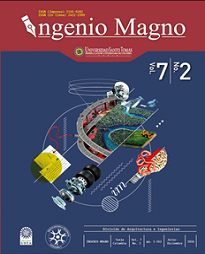Evaluation of the effects of varying water flow on the levels of Ammonium, Nitrate and Ph of a prototype aquaponic system
Main Article Content
Abstract
Downloads
Article Details
DECLARATION OF ORGINIALITY OF SUBMITTED ARTICLE
With this document, I/We certify that the article submitted for possible publication in the institutional journal INGENIO MAGNO of the Research Center Alberto Magno CIIAM of the University Santo Tomás, Tunja campus, is entirely of my(our) own writing, and is a product of my(our) direct intellectual contribution to knowledge.
All data and references to completed publications are duly identified with their respective bibliographical entries and in the citations thus highlighted. If any adjustment or correction is needed, I(we) will contact the journal authorities in advance.
Due to that stated above, I(we) declare that the entirety of the submitted material is in accordance with applicable laws regarding intellectual and industrial property, and therefore, I(we) hold myself(ourselves) responsible for any complaint related to it.
If the submitted article is published, I(we) declare that I(we) fully relinquish publishing rights of the article to the University Santo Tomás, Tunja campus. As remuneration for this relinquishment of rights, I(we) declare my(our) agreement to receive two (2) copies of the edition of the journal in which my(our) article appears.
References
Organización de las Naciones Unidas para la Alimentación y la Agricultura (FAO) (2012). The state of World Fisheries and Aquaculture. Roma.
Kioussis, D. R., Wheaton, F. W. y Kofinas, P. (2000). Reactive nitrogen and phosphorus removal from aquaculture wastewater effluents using polymer hydrogels. Aquacult Engineering, 23, 315-332. Doi: 10.1016/S0144-8609(00)00058-3
Menegaki, A. N., Hanley, N. y Tsagarakis, K. P. (2007). The social acceptability and valuation of recycled water in Crete; A study of consumers and farmers attitudes”. Ecological Economics, 52, 7-18. Doi: 10.1016/j. ecolecon.2007.01.008
Meng, R., He, L. S., Xi, B. D., Hu, X. y Li, Y. Y. (2009). Experimental study on purifying aquaculture wastewater between bacillus and nitrifying bacteria. Environmental Science & Technology, 32(11), 28-31.
Oca, J. y Masaló, I. (2013). Flow pattern in aquaculture circular tanks: Influence of flow rate, water depth, and water inlet & outlet features. Aquacultural Engineering, 52, 6572. Doi: 10.1016/j.aquaeng.2012.09.002
Pagand, P., Blancheton, J. P. y Claude, C. (2000). A model for predicting the quantities of dissolved inorganic nitrogen released in effluents from a sea bass (Dicentrarchus labrax) recirculating water system. Aquacultural Engineering, 22, 137-153. Doi: 10.1016/ S0144-8609(00)00037-6
Piedrahíta, R. H. (2003). Reducing the potential environmental impact of tank aquaculture effluents through intensification and recirculation. Aquaculture, 226(1-4), 35-44. Doi: 10.1016/S0044-8486(03)00465-4.
Rakocy, J. (2003). Initial economic analysis of aquaponic systems. European Aquaculture Society, 33, 58-64.
Randall, D. J. y Tsui, T. K. (2002). Ammonia toxicity in fish. Marine Pollution Bulletin, 45, 17-23. Doi: 10.1016/ S0025-326X(02)00227-8
Ridha, M. T. y Cruz, E. M. (2001). Effect of biofilter media on water quality and biological performance of the Nile Tilapia Oreochromis niloticus L. reared in a simple recirculating system. Aquacultural Engineering, 24, 57–166. Doi: 10.1016/S0144-8609(01)00060-7
Rijin, J. V. (2013). Waste treatment in recirculating aquaculture systems. Aquacultural Engineering, 53, 49-56. Doi: 0.1016/j.aquaeng.2012.11.010
Romero, R., Muriel, J. L, García, I. y Muñoz de la Peña, D. (2012). Research on automatic irrigation control: State of the art and recent results. Agricultural Water Management, 114, 59-66. Doi: 10.1016/j. agwat.2012.06.026.
Schneider, O., Sereti, V., Eding, E. H. y Verreth, J. A. (2005). Analysis of nutrient flows in integrated intensive aquaculture systems. Aquacultural Engineering, 32, 379-401. Doi: 10.1016/j.aquaeng.2004.09.001
Teichert, C. y Oddington, D. R. (2010). Treatment of harvest discharge from intensive shrimp ponds by settling”. Aquacultural Engineering, 19, 147-161. Doi: 10.1016/S0144-8609(98)00047-8.
Tyson, R. V., Treadwell, D. D. y Simonne, E. H. (2011). Opportunities and challenges to sustainability in aquaponics. HortTechnology, 21(1), 6-13.
Valente, L. M., Linares, F., Villanueva, J. L., Silva, J.M., Espe, M., Escórcio, C., Pires, M. A., Saavedra, M. J., Borges, P., Medale, F., Álvarez, B. y Peleteiro, J. B. (2011). Dietary protein source or energy levels have no major impact on growth performance, nutrient utilisation or flesh fatty acids composition of marketsized. Aquaculture, 318, 128-137. Doi: 10.1016/j. aquaculture.2011.05.026

